The therapeutic potential of glucagon-like peptide-1 receptor analogs for neuroinflammation in the setting of asthma
- PMID: 40474934
- PMCID: PMC12140623
- DOI: 10.37349/eaa.2025.100967
The therapeutic potential of glucagon-like peptide-1 receptor analogs for neuroinflammation in the setting of asthma
Abstract
Glucagon-like peptide-1 (GLP-1) is a hormone that regulates blood glucose levels and is produced by the enteroendocrine glands in the large and small intestines in response to the consumption of foods that contain carbohydrates, fats, and proteins. When GLP-1 is secreted, it acts on the pancreas to increase insulin production and secretion, while decreasing pancreatic glucagon secretion in order to lower serum glucose. However, GLP-1 also regulates metabolism through the gut-brain axis. While GLP-1 is primarily produced in the gut and released into the bloodstream, small quantities of it can also be synthesized in distinct areas of neurons located in the hindbrain. Recent studies have proposed that GLP-1 receptor (GLP-1R) agonists (GLP-1RAs) may protect against neuroinflammatory diseases. GLP-1RAs may also be a therapeutic target for asthma as animal models show that these drugs reduce allergen-induced airway inflammation, as the GLP-1R is expressed on lung epithelial and endothelial cells. There is a notable association between insulin resistance and the onset of asthma, particularly among obese people, with this association suggesting that metabolic dysfunction may play a role in asthma development. There is also evidence that there may be a link between asthma pathobiology and neuroinflammation, suggesting that GLP-1 and its analogs may regulate neuroinflammatory pathways that contribute to asthma pathogenesis. Interest is growing, though research remains limited, in how inflammation in the nervous system and lung might be linked. This review will explore how GLP-1R signaling could inhibit interdependent inflammation in both the lung and nervous system. This review will first focus on the inflammation that is known to exist in asthma, then pivot to the current state of neural regulation of asthma, and finally speculate on how GLP-1RA signaling could inhibit both neural and lung inflammation in asthma treatment.
Keywords: Glucagon-like peptide-1 receptor; asthma; glucagon-like peptide-1 receptor agonist; neuroinflammation.
Conflict of interest statement
Conflicts of interest The authors declare that they have no conflicts of interest.
Figures






Similar articles
-
Glucagon-Like Peptide 1 Receptor (Glp1r) Deficiency Does Not Appreciably Alter Airway Inflammation or Gut-Lung Microbiome Axis in a Mouse Model of Obese Allergic Airways Disease and Bariatric Surgery.J Asthma Allergy. 2025 Feb 27;18:285-305. doi: 10.2147/JAA.S478329. eCollection 2025. J Asthma Allergy. 2025. PMID: 40046174 Free PMC article.
-
Evaluating the glucagon-like peptide-1 receptor in managing asthma.Curr Opin Allergy Clin Immunol. 2022 Feb 1;22(1):36-41. doi: 10.1097/ACI.0000000000000797. Curr Opin Allergy Clin Immunol. 2022. PMID: 34772827 Free PMC article. Review.
-
Potential role of tirzepatide towards Covid-19 infection in diabetic patients: a perspective approach.Inflammopharmacology. 2023 Aug;31(4):1683-1693. doi: 10.1007/s10787-023-01239-4. Epub 2023 May 19. Inflammopharmacology. 2023. PMID: 37208555 Free PMC article. Review.
-
Glucagon-Like Peptide-1 and Hypothalamic Regulation of Satiation: Cognitive and Neural Insights from Human and Animal Studies.Diabetes Metab J. 2025 May;49(3):333-347. doi: 10.4093/dmj.2025.0106. Epub 2025 May 1. Diabetes Metab J. 2025. PMID: 40367985 Free PMC article. Review.
-
Glucagon-like peptide 1 receptor (GLP-1R) agonist relieved asthmatic airway inflammation via suppression of NLRP3 inflammasome activation in obese asthma mice model.Pulm Pharmacol Ther. 2021 Apr;67:102003. doi: 10.1016/j.pupt.2021.102003. Epub 2021 Feb 12. Pulm Pharmacol Ther. 2021. PMID: 33588055
References
-
- Slejko JF, Ghushchyan VH, Sucher B, Globe DR, Lin SL, Globe G, et al. Asthma control in the United States, 2008–2010: indicators of poor asthma control. J Allergy Clin Immunol. 2014;133:1579–87. - PubMed
-
- Papi A, Brightling C, Pedersen SE, Reddel HK. Asthma. Lancet. 2018;391:783–800. - PubMed
-
- Backman H, Räisänen P, Hedman L, Stridsman C, Andersson M, Lindberg A, et al. Increased prevalence of allergic asthma from 1996 to 2006 and further to 2016—results from three population surveys. Clin Exp Allergy. 2017;47:1426–35. - PubMed
Grants and funding
LinkOut - more resources
Full Text Sources
